The Longji Terraces
Longji Terraces, also known as Longji Rice Terraces, refer to the terraces developed on Longji Mountain. They are located about 80 kilometers from Guilin City. The Longji Terraces are distributed between 300 and 1100 meters above sea level, with a maximum slope of up to 50 degrees. Access to the terraces is through mountain roads that ascend to about 600 meters above sea level, reaching an altitude of 880 meters on the terraces.
History of Longji Terraces
The mountainous region of Nanling, where Longsheng is located, saw the early cultivation of long-stemmed rice between 6,000 and 12,000 years ago, becoming one of the birthplaces of artificial rice cultivation in the world. During the Qin and Han dynasties, terrace farming methods had already been established in Longsheng. During the Tang and Song dynasties, the Longsheng terraces were developed on a large scale and basically reached the current scale during the Ming and Qing dynasties. The Longji terraces have a history of at least 2,300 years and are considered the cradle of terraces in the world.
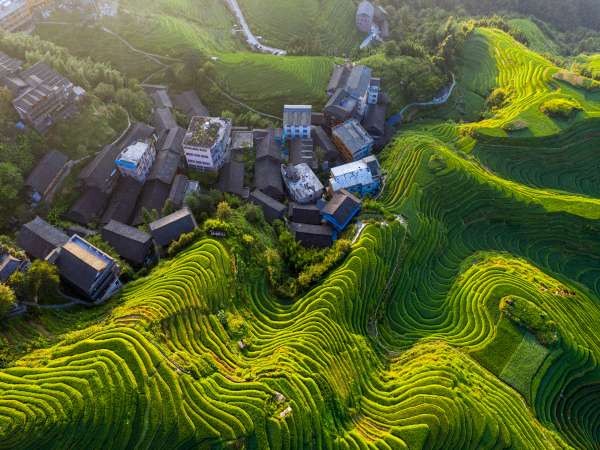
Attractions of Longji Terraces
Observation Point Number 1 and 2
Longji Terrace is divided into two observation points, Observation Point Number 1 and Observation Point Number 2. Observation Point Number 1 is located at the top east of the village, and is a little further away. Observation Point Number 2 is relatively closer.
There is a flat path connecting observation points 1 and 2, from where you can see the famous landscape of Longji terraces known as "Seven Stars Accompanying the Moon". This landscape is the essence of the Longji terraces, which consist of seven small terraces on the top of the mountain and one larger terrace. The entire mountain is covered with narrow terraces, and the embankments look like contour lines.
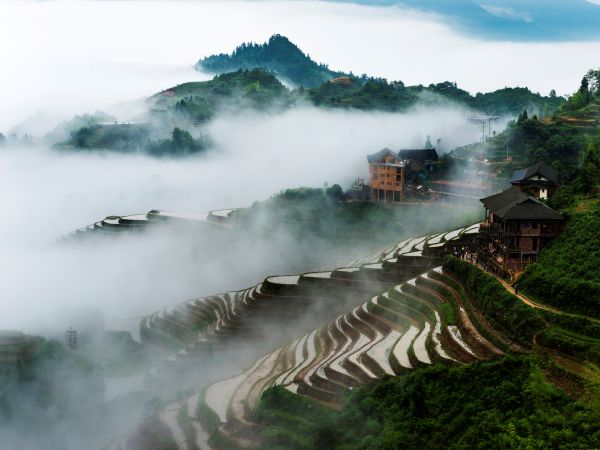
A few altitude higher than the Longji Terraces, there is another set of terraces called Jinkeng Terraces. From Observation Point Number 1 in Ping'an, it takes 3 to 4 hours to walk there. The accommodation conditions are not as good as in Ping'an, but the terraces are a little larger and the people are more hospitable.
In the southeastern part of Longsheng County, Longji City, there is a set of large-scale terraces. There are usually three entrances to Longji Terraces: one in Ping'an Village, one in Dazhai Village, and one in Longji Village (former Longji Zhuang Village).
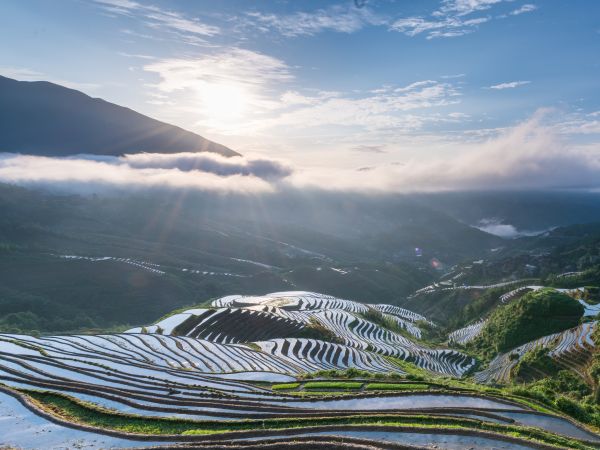
The Red Terraced of Jinkeng Dazhai
The red terraced fields of Jinkeng Dazhai are surrounded by mountains on all four sides, looking like a natural crater. Jinkeng Dazhai's red ancestors migrated from the Dongting and Wuxi region in Hunan, bringing with them advanced technology for rice cultivation. Nowadays, the field in front of the Dazhai Village School is the place where the red ancestors first harvested and cultivated, being the ancestral field of Jinkeng Dazhai. Life and art are so interconnected. The ancestors who cleared the land in Longji did not imagine that the fields they tilled with so much effort would become a great work of art; The terraced fields were transformed into a world of charming and elegant curves.
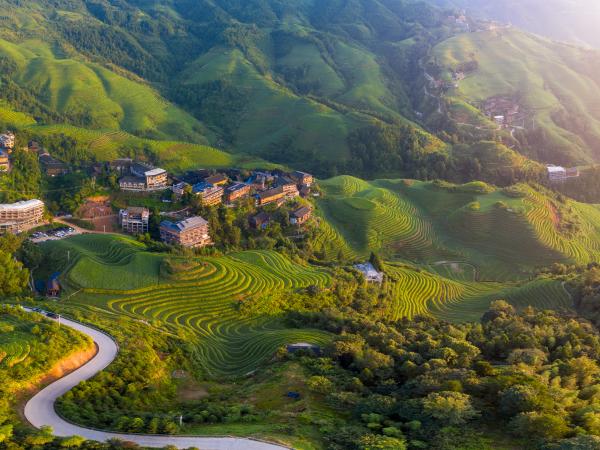
The red terraced fields of Jinkeng Dazhai have three viewing points, namely Shaoke of West Mount, Thousand Layers of Heavenly Stairs of the Great Boundary, and Golden Buddha Peak. These three viewing points form a place secluded from the profane world. . Thousand Layers of Heavenly Stairs of the Great Boundary offers views of stepped terraces that resemble stairs, stacking directly towards the clouds, as if ascending to the sky. From the Shaoke Viewpoint of West Mount, you can see Mount Maoer of Xing'an and the highest peak of Longsheng, Fupingbao, at an altitude of 1918 meters, from which you can enjoy views of 40 to 50 kilometers squares of "golden thread hanging pumpkins" and the setting sun.
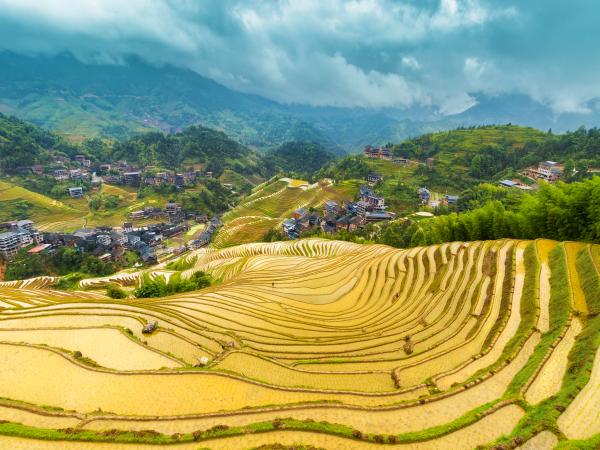
The terraced fields of gold in Dazhai village. Here, due to the production of gold, it was given the name Jinkeng. The topography of Jinkeng is both a huge "sinkhole" and a small circular area that covers like a palace. Looking up from the bottom of the hole, you see a series of terraces stretching skyward, one after another, on kilometer-high slopes. The circular body of the mountain, which extends between four and five kilometers, coils like a coiled dragon. Unlike the terraces of Ping'an, here a more robust beauty is presented, which is shocking. In addition to the two legendary landscapes of "Fight for the Treasure of the Two Dragons" and "Leap of the Two Lions", within the Jinkeng Terraced Fields area, there are also three new landscapes: "The Thousand-Layered Stairs", "The Top of the Golden Buddha" and "The Joy of the Western Mountain", which form another dream paradise in the Longji Mountains, away from the mundane world.
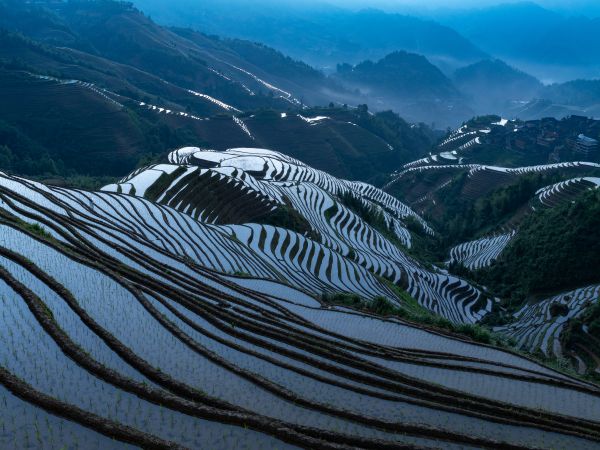
The Four Treasures of Longji
·Tea: Longji tea was a tribute during the Qing dynasty.
·Peppers: Longji peppers have a unique and spicy aroma, with thick skin and a level
moderately spicy.
·Rice wine: Longji rice wine, made from glutinous rice, is sweet and delicious.
·Glutinous rice: Longji glutinous rice is used to make rice wine and has a
reputation similar to that of Longsheng's Maotai.

















